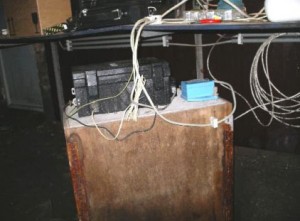Seismology and Gravimetry
As a public service part of a Federal Scientific Institution, the most important responsibilities of the Seismology Section of the Royal Observatory of Belgium (ROB) are the preservation, the development, the study, and the promotion of the scientific heritage related to earthquake activity in Belgium and in the world.
Under the terms of these principles, the Seismology Section closely tracks the technological and scientific developments in the domain of seismology, carries out scientific research, and provides information to the public and private companies.
To realize these objectives, our actions consist of :

Pillar of the seismometer (blue) and the accelerometer (black box) in the station of La Chartreuse (LCH) in Liège.
- Monitoring of the seismic activity in Belgium and surrounding areas. In order to provide a daily seismic activity report, the seismology section develops and maintains a network of seismic stations covering the Belgian territory (and part of Luxembourg);
- Maintenance and integration within the seismic network of the absolute and superconducting gravimeters of the ROB (since 1999);
- Analysis and archival of the acquired seismic data;
- Development of an on-line database that can be freely accessed;
- Distribution of seismic measurements to international seismological centres (EMSC, ISC …);
- Initiation and implementation of national and international research projects in the field of seismology and paleoseismology. These projects focus on the study of past and present seismic activity in Belgium and other parts of the world with similar seismic activity (e.g., Tanzania, Bulgaria …);
- Diffusion of knowledge and scientific and technological expertise to the national and international scientific community, and on request to public services and private companies;
- Informing the media and public, especially on the occasion of particular seismic events.
Whenever an important earthquake is felt on the Belgian territory, the Seismology Section provides :
- Rapid preliminary determination of the earthquake epicentre and local magnitude;
- Diffusion of this preliminary information to the federal, regional and local authorities, and in particular to the Coordination and Crisis Centre of the Belgian Government;
- Communication to the public through the media;
- Collecting information concerning the effect of the earthquake, by means of a public inquiry through our website, and an inquiry at the local administration level through a specific form sent out immediately after the earthquake;
- More detailed investigation of additional earthquake parameters;
- If required, a report is filed to the FPS of Internal Affairs, which will decide based on evaluation of the magnitude and the macroseismic inquiries, whether or not the earthquake will be officially declared a disaster, which would allow for intervention by the Disaster Fund.
Latest Earthquakes
1.2
BRUEGGEN (DE)
30 Jun 2025 - 17:54:13 UT1
KASBACH-OHLENBERG (DE)
28 Jun 2025 - 17:28:05 UT1.3
SOMEREN (NL)
27 Jun 2025 - 21:24:17 UT0.3
JALHAY (BE)
25 Jun 2025 - 19:29:41 UT0.8
BAELEN (BE)
21 Jun 2025 - 13:01:08 UT0.7
ROTH BEI PRUEM (DE)
21 Jun 2025 - 00:40:23 UT0.2
JALHAY (BE)
19 Jun 2025 - 10:11:24 UT0.6
WAIMES (BE)
19 Jun 2025 - 07:14:09 UT1.3
OCHTENDUNG (DE)
17 Jun 2025 - 06:11:42 UT-0.1
IMGENBROICH (DE)
14 Jun 2025 - 03:54:24 UT-0.6
IMGENBROICH (DE)
13 Jun 2025 - 03:38:53 UT1.2
